
Published in THE TIMES
Our project was published in THE TIMES. Click below for more details.

Our project was published in THE TIMES. Click below for more details.
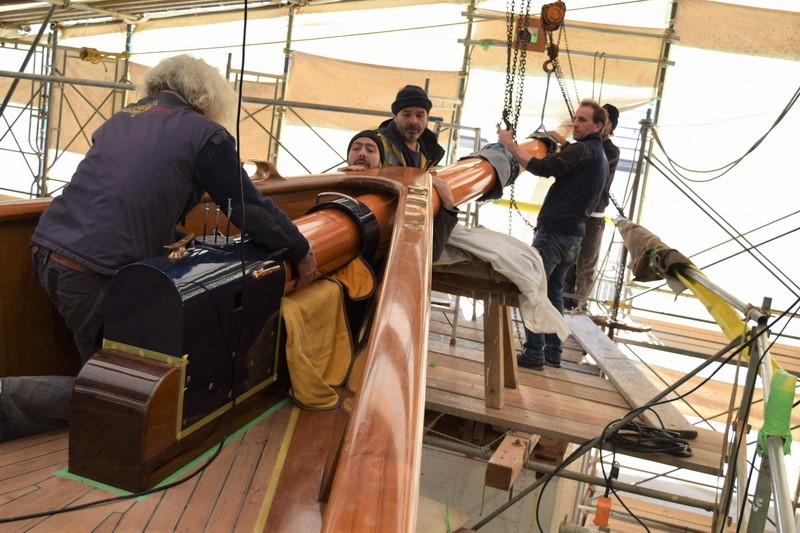
This week saw the installation of the bowsprit. Billy prepared the block and tackles to get the spar from the ground and into the scaffold, yesterday, and this morning shipwrights Paul and Ben, along with Bill and Chuck the rigger—worked in unison to get it in place, paying close attention to clearances on either side of the hole in the bow.
The bowsprit is made of Douglas Fir, otherwise known as Oregon Pine, the same wood as the main and mizzen masts. With everyone’s help, it fits perfectly, and the graceful shape of Cynara’s hull and bowsprit can finally be seen. Very soon now she will be ready to enter the water.
The team previously finished the primer and under coats of the hull, and last week saw the application of the first layers of her white gloss coats.
Pascal from France and Ian from South Africa are fitting the propeller shaft. Of course, it’s not as simple as that, as there is a gearbox, then a constant motion joint, then a stern gland followed by a long propeller shaft casing that penetrates the stern post. The engine drives the shaft via the gearbox (forward and reverse), the gland stops seawater from entering and the prop provides the “grip” in the water. Though mostly hidden below the engine room floor, this is how Cynara performs under power.
Meanwhile, after weeks of work, Graham, who hails from Ireland, has been putting the finishing touches to the rudder. He now has it mounted with just the right amount of “feel” in the steering gear mechanism, and is rightly looking very satisfied with the results.
Last week the bilges were filled with water to test the water tightness of the lower bilge area. Richard marked the problem spots on the outside of the hull, where sealing will have to be done.
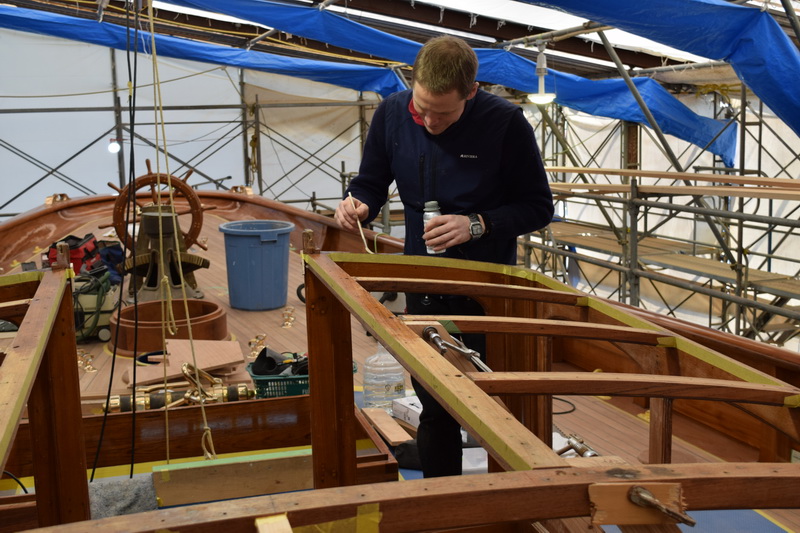
Mattis is preparing the roof of the main deck house.
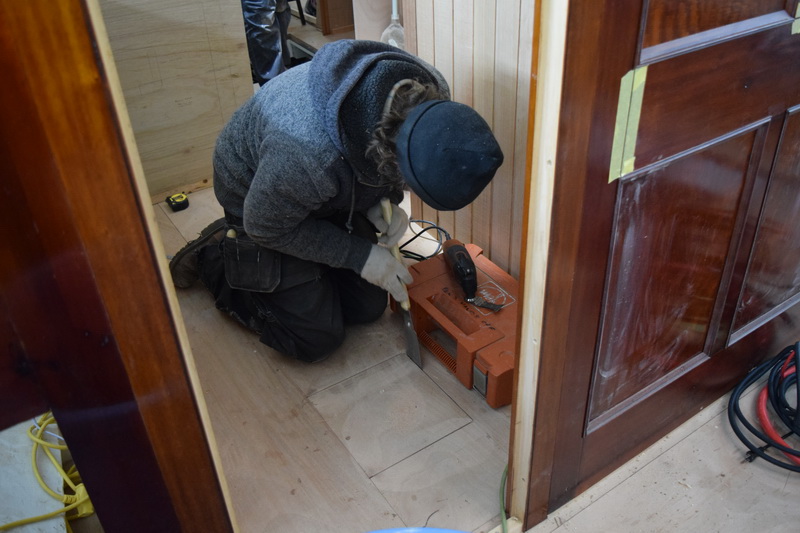
John is installing an access hatch that will be used to service the cable junctions near the base of the mast.
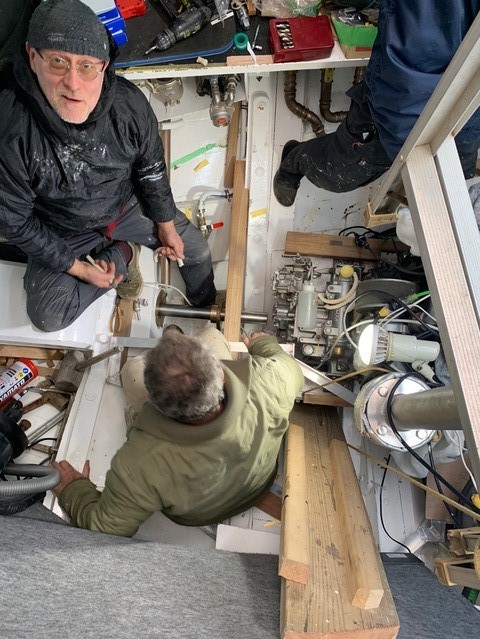
Pascal is caught in action with the stern gland packing. This keeps the seawater out as the propeller shaft rotates.
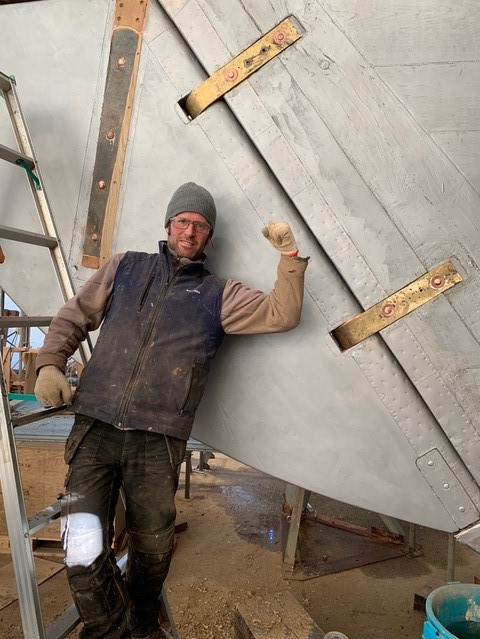
Graham poses proudly with the rebuilt rudder.
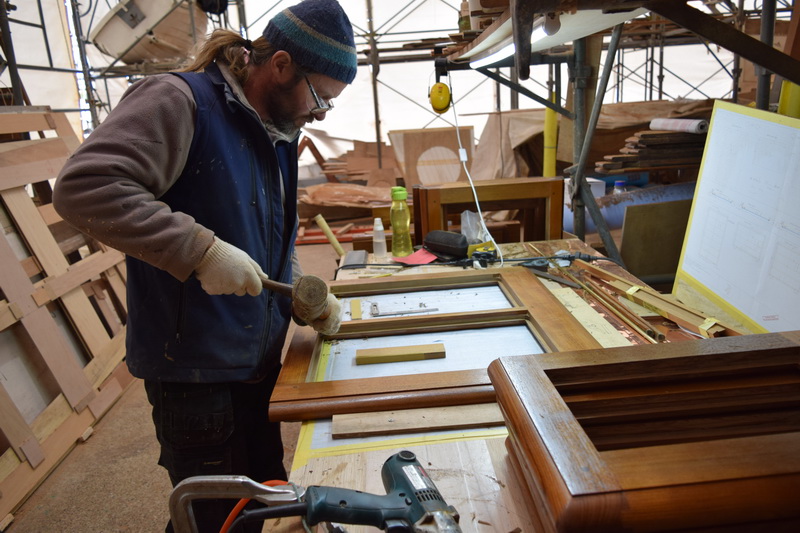
Head rigger Chuck arrived at Seabornia last Friday from the south of France, together with Nat, a rigger from Maine. The riggers’ job is to prepare the deck, the mast, and its fittings for installation, which will take place soon after Cynara is put back in the water. The installation of other mast-related items on the deck is also nearing completion, and Chuck has been discussing issues that have arisen since he was last on site with Paul and Ben. This means we are entering the final stage of the restoration process.
The interior team led by Lewis was busy repairing the paneling as well as all the original furniture that has been stored in the cabinet-makers’ and joiners’ tents. They have been applying shellac, a natural resin, to the original flame mahogany saloon wall panels. Shellac has been used as a clear coating for over 3,000 years, but is very thin compared with modern coatings, and must be repeatedly applied to achieve the desired color and gloss. It’s time consuming work, but touchup of small scratches and minor damage to the wood finish can be done without redoing the whole piece.
Today, a test of the bilge pumps took place in the engine room and bilges, looking for hull leakage. The wood used for Cynara’s keel and deadwood are from trees hundreds of years old, and have worked well over the past 93 years. But the boat’s entire structure has been drying out on land for the past 3 years, so there’s been a lot of shrinkage in her hull. Some leaks were found, as expected, and are being dealt with. The water that was added to the bilges will soak in, swelling the timber, and speeding up the leak sealing process.
Varnishing on the deck, and the painting of the hull continues. Paul is always reminding the crew to keep the shipyard clean: it reduces dust and reduces the risk of the boat getting scratches, dents, and other damage.
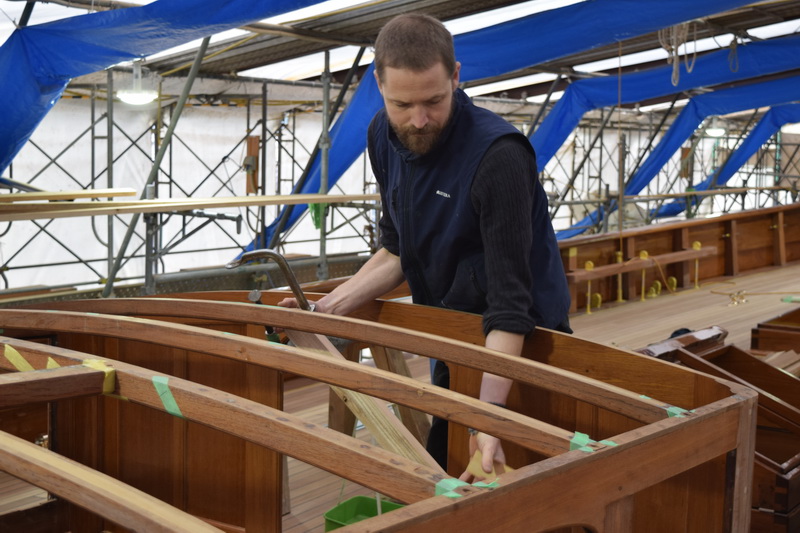
Mattis is installing the roof beams of the main deck house.
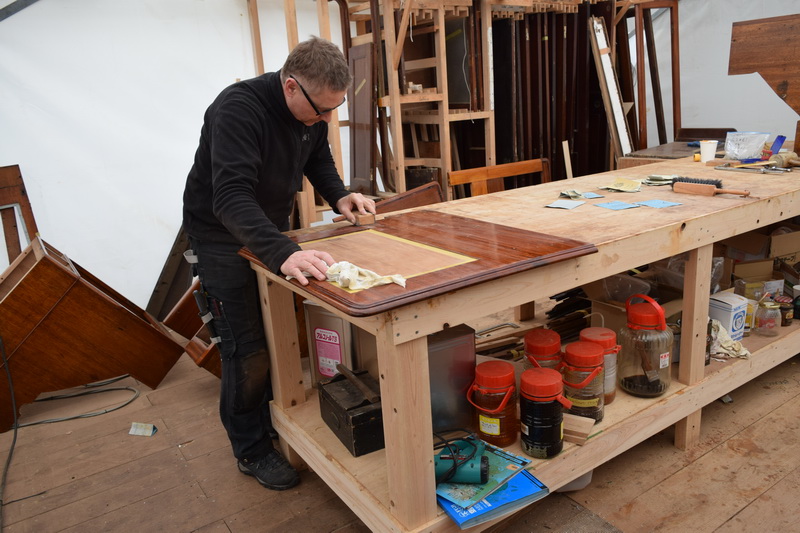
Jesper is working on applying shellac to parts of the interior furniture.

Nico works on restoring the fife rail, which is like a pin rail, found at the deck edge, except it’s in the middle of the deck.
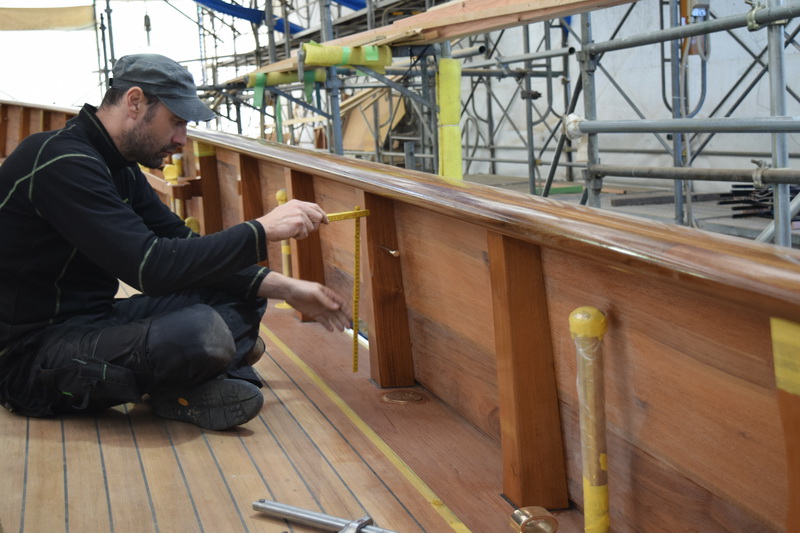
Work is still ongoing on deck, but much of the focus has shifted to the interior. The mahogany panels are starting to be installed, and some of the cabin partitions constructed of poplar (as were the originals) have been trial fitted. The original desk from the main saloon is being repaired, and it’s a time-consuming process: Repairs are made, replacing broken or decayed parts, which eventually must be matched to the original wood finish. Then the original shellac is removed.
The electrical wiring work also continues. Much of it has to be installed under the floor, where the space is limited and the temperature is chilly.
In the engine room, the frame supporting the floor plates was dry fitted. Next to be installed are the floor plates, which are checkered aluminum.
Back on the deck, the caprails (also called capping rails) that run the length of the boat are being varnished. Like the masts, they require many, many coats.
Paul’s decorative detail at the bow—which is a copy of the original—is completed to the undercoat stage, and the floral patterns are gradually emerging.

The decorative detail at the stem, which is a copy of the original design, was done by Master Shipwright Paul.
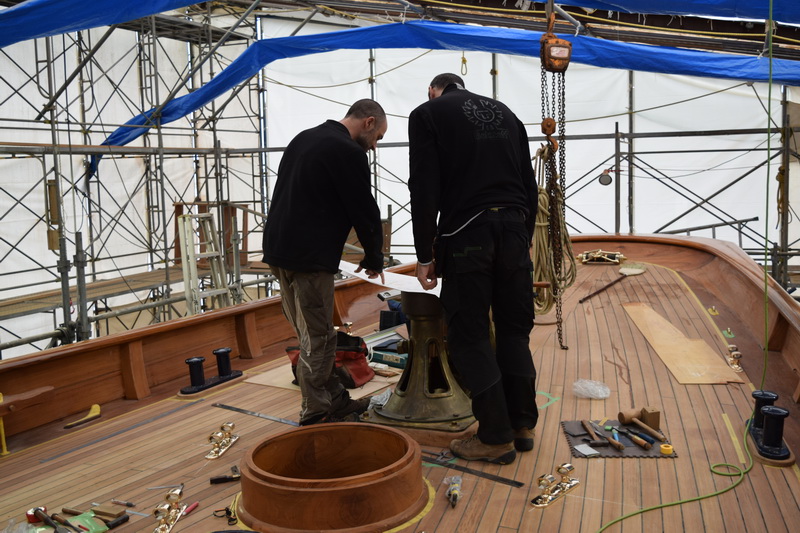
Richard and Nico are studying the deck plan, discussing the correct deck hardware positions.

Kawashima is cutting the mortices in the frame for one of the bulkheads.
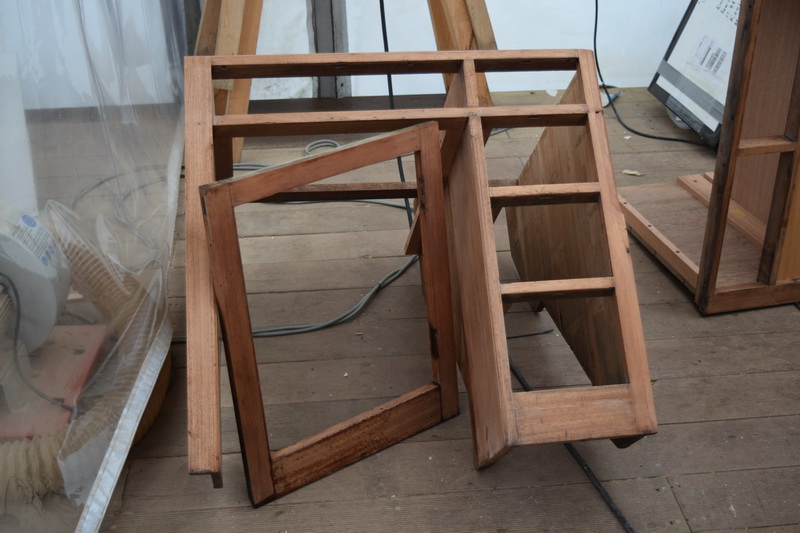
The desk from the main saloon has been stripped of shellac before final restoration. Notice the way the side panels have been cut to fit the slope of the hull.

After being spray-painted in an elegant dark blue color, chosen by Mr. Watanabe, the mooring bitts, fairleads, and hardware for the bowsprit are being laid out on deck in their various positions. The varnishing team is taking a break from mast varnishing and is now focusing on applying varnish to the bulwarks, coach house bases, etc., using the techniques they learned from the professional shipwrights. The sandpapering is repetitive and very laborious work, requiring the craftsman to keep his body bent over while sanding along the curved shape of Cynara’s brightwork for hours.
Ben is in charge of the installation of the pipes, ducts, and other equipment under the floors. Much of the interior work has to be carried out simultaneously, but the team is working efficiently in the limited space and time available. Furniture, much of it original, is temporarily installed to check for best fit, then removed for fine adjustments, restoration, and varnishing. The colors in the superb flame mahogany paneling of the saloon and corridors are beautiful and elegant.
Later this month, the rigger team will arrive on site to complete the mast, and prepare the rigging.
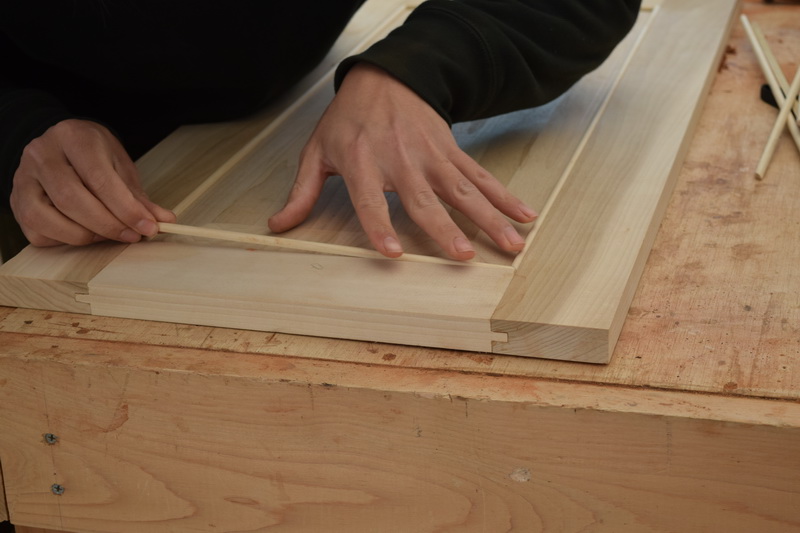
Toshi, the furniture designer / cabinetmaker is fitting the retaining strips which hold the cupboard door insert panel in the frame.

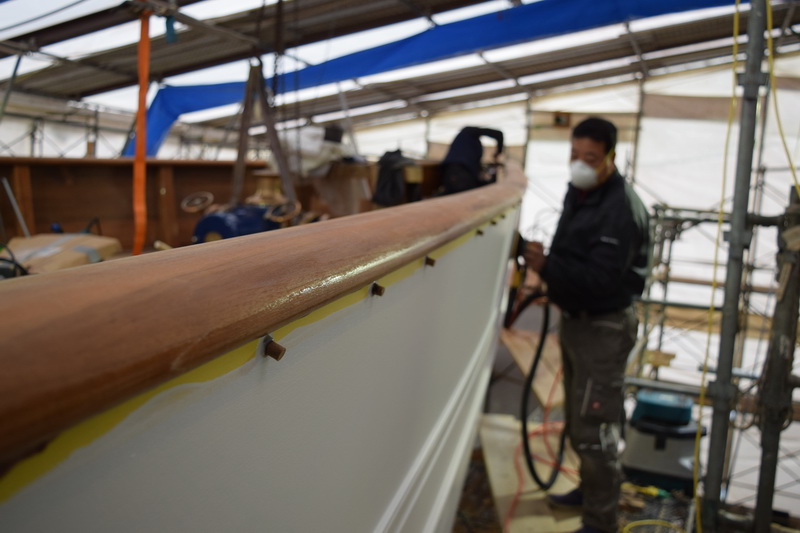
The capping rail is held using mortice and tenon joints.

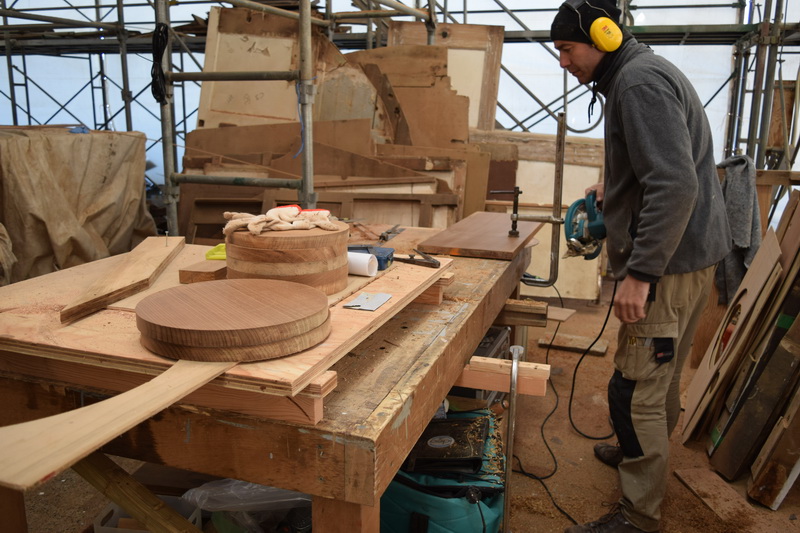
Nico, our Italian shipwright, is making winch bases in teak for the 9 winches to be fitted on deck.